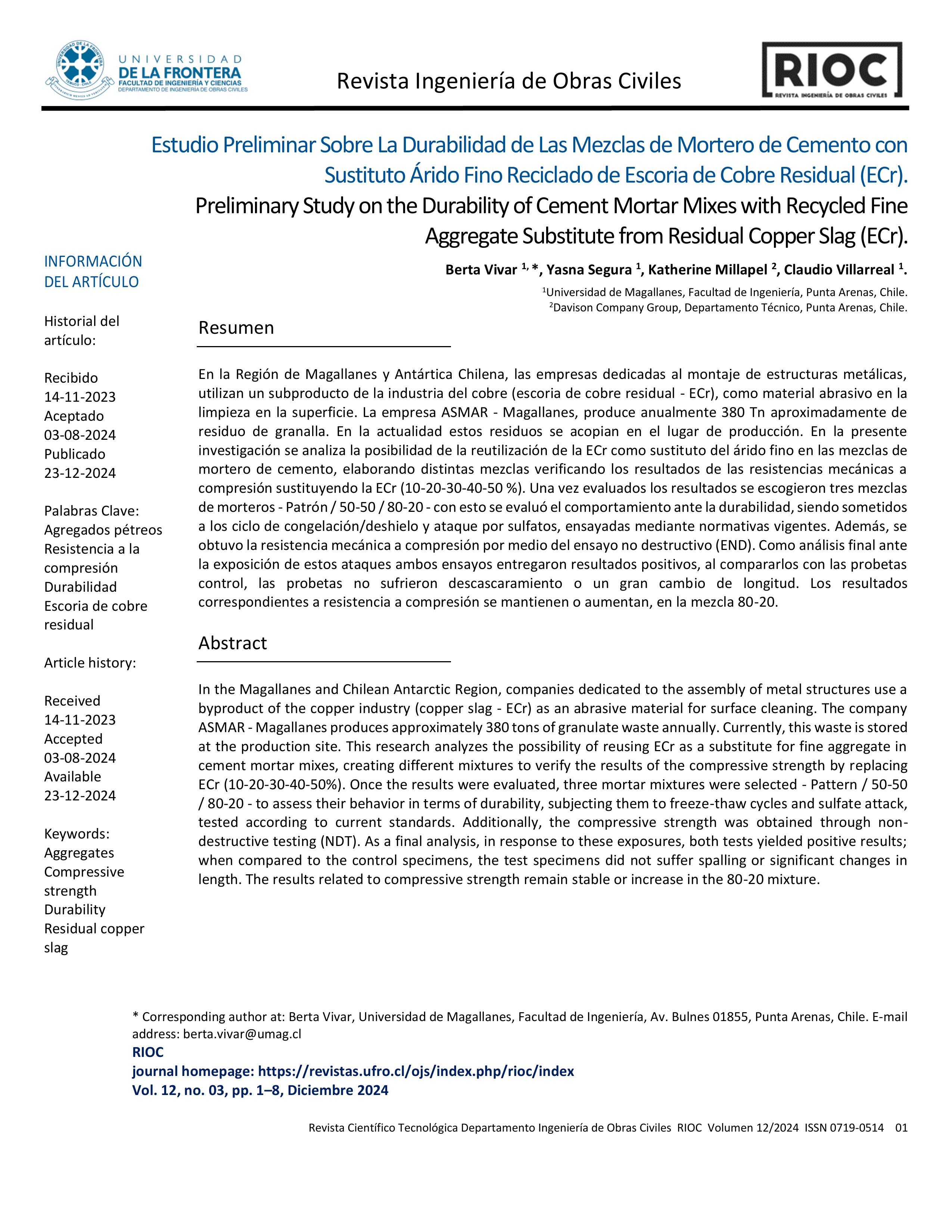Estudio Preliminar Sobre La Durabilidad de Las Mezclas de Mortero de Cemento con Sustituto Árido Fino Reciclado de Escoria de Cobre Residual (ECr)
Palabras clave:
Agregados pétreos, Resistencia a la compresión, Durabilidad, Escoria de cobre residualResumen
En la Región de Magallanes y Antártica Chilena, las empresas dedicadas al montaje de estructuras metálicas, utilizan un subproducto de la industria del cobre (escoria de cobre residual - ECr), como material abrasivo en la limpieza en la superficie. La empresa ASMAR - Magallanes, produce anualmente 380 Tn aproximadamente de residuo de granalla. En la actualidad estos residuos se acopian en el lugar de producción. En la presente investigación se analiza la posibilidad de la reutilización de la ECr como sustituto del árido fino en las mezclas de mortero de cemento, elaborando distintas mezclas verificando los resultados de las resistencias mecánicas a compresión sustituyendo la ECr (10-20-30-40-50 %). Una vez evaluados los resultados se escogieron tres mezclas de morteros - Patrón / 50-50 / 80-20 - con esto se evaluó el comportamiento ante la durabilidad, siendo sometidos a los ciclo de congelación/deshielo y ataque por sulfatos, ensayadas mediante normativas vigentes. Además, se obtuvo la resistencia mecánica a compresión por medio del ensayo no destructivo (END). Como análisis final ante la exposición de estos ataques ambos ensayos entregaron resultados positivos, al compararlos con las probetas control, las probetas no sufrieron descascaramiento o un gran cambio de longitud. Los resultados correspondientes a resistencia a compresión se mantienen o aumentan, en la mezcla 80-20.
Descargas

Descargas
Publicado
Cómo citar
Número
Sección
Licencia
Derechos de autor 2024 Berta Vivar , Yasna Segura , Katherine Millapel , Claudio Villarreal

Esta obra está bajo una licencia internacional Creative Commons Atribución 4.0.
Los autores/as que publiquen en esta revista aceptan las siguientes condiciones:
- Los autores/as conservan los derechos de autor y ceden a la revista el derecho de la primera publicación, con el trabajo registrado con la licencia de atribución de Creative Commons, que permite a terceros utilizar lo publicado siempre que mencionen la autoría del trabajo y a la primera publicación en esta revista.
- Los autores/as pueden realizar otros acuerdos contractuales independientes y adicionales para la distribución no exclusiva de la versión del artículo publicado en esta revista (p. ej., incluirlo en un repositorio institucional o publicarlo en un libro) siempre que indiquen claramente que el trabajo se publicó por primera vez en esta revista.
- Se permite y recomienda a los autores/as a publicar su trabajo en Internet (por ejemplo en páginas institucionales o personales) antes y durante el proceso de revisión y publicación, ya que puede conducir a intercambios productivos y a una mayor y más rápida difusión del trabajo publicado (vea The Effect of Open Access).



